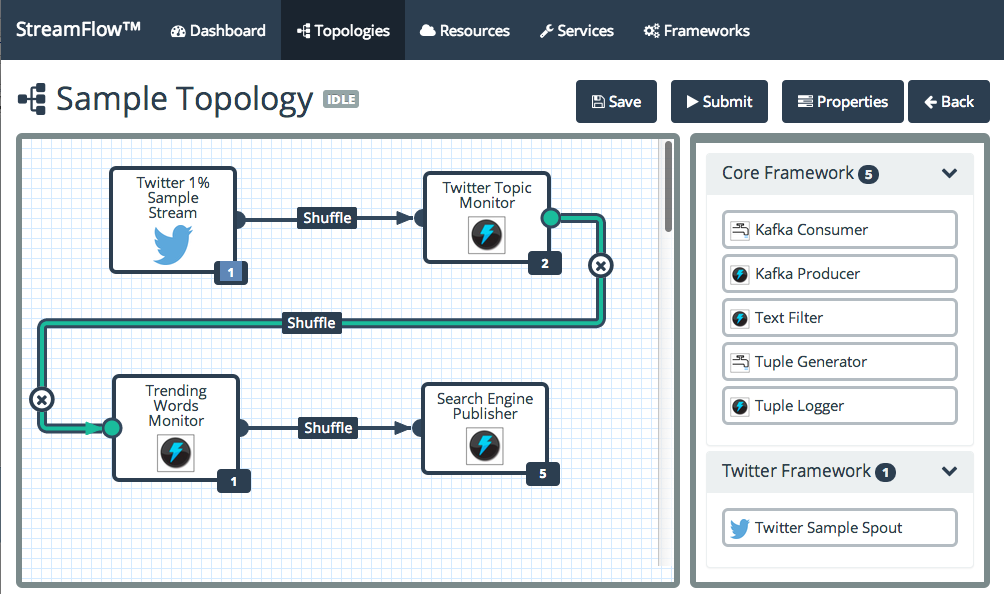StreamFlow™ is a stream processing tool designed to help build and monitor processing
workflows. The ultimate goal of StreamFlow is to make working with stream processing frameworks
such as Apache Storm easier, faster, and with "enterprise" like management functionality.
StreamFlow also provides a mechanism for non-developers such as data scientists, analysts, or
operational users to rapidly build scalable data flows and analytics.
StreamFlow provides the following capabilities:
- A responsive web interface for building and monitoring Storm topologies.
- An interactive drag and drop topology builder for authoring new topologies
- A dashboard for monitoring the status and performance of topologies as well as viewing aggregated topology logs.
- A specialized topology engine which solves some Storm complexities such as ClassLoader isolation and serialization and provides a mechanism for dependency injection.
- A modular framework for publishing and organizing new capabilities in the form of Spouts and Bolts.
The following is a simple depiction of the StreamFlow stack. The web interface is built using open source web frameworks and is backed by a series of reusable web services. StreamFlow is capable of authoring and managing topologies dynamically using a series of reusable Frameworks. These Frameworks are simply JAR files comprised of standard Storm Spouts and Bolts with a metadata configuration file which exposes the frameworks. StreamFlow utilizes a custom topology driver which is used to bootstrap and execute a topology along with StreamFlow specific configuration logic.
The following is a description of some core StreamFlow concepts and terminology.
Components represent business logic modules which are draggable in the StreamFlow UI. Examples of Components include Storm Spouts and Storm Bolts.
A grouping of related Components and their associated metadata. Ideally elements of a framework should all be compatible when wired together on a topology as they share the same protocol. Frameworks might be organized around a set of technologies or domains. An analogy would be a Java Library or Objective C Framework. Topologies have frameworks as dependencies.
A resource is an object used by spouts/bolts in order to externalize common state. For example, an object which represents a technical asset in the environment/cluster such as a database or Kafka queue. Alternatively, a resource might provide an uploaded file or container of global state. Resources should be used to encapsulate functionality outside of a bolt/spout if that information is used in several places in a topology or within multiple topologies. Resources also provide a useful mechanism for injecting parameters, connections, or state into a bolt/spout making the spout or bolt simpler, easier to write, and more testable.
Seriaizations allow for the definition of custorm serializers/deserializers. Specifically these serializations should be specified in the Kryo format to properly integrate with Storm.
Topologies in Storm define the processing logic and link between nodes to describe the data flow. StreamFlow utilizes registered components to allow users to dynamically build topologies in a drag and drop interface. This allows topologies to be built using existing components without requiring additional code.
The StreamFlow Wiki is the best place to go to learn more about the StreamFlow architecture and how to install and configure a StreamFlow server in your environment.
https://github.com/lmco/streamflow/wiki;
Here are some quick links to help get you started with StreamFlow:
- Getting Started with StreamFlow
- Installing and Running StreamFlow
- Configuring StreamFlow
- How Does StreamFlow Work?
- Developing StreamFlow Frameworks
If you have any questions or issues please feel free to contact the development team using one of the following methods.
StreamFlow is copyright 2014 Lockheed Martin Corporation.
Licensed under the [Apache License, Version 2.0] license (the "License"); you may not use this software except in compliance with the License.
Unless required by applicable law or agreed to in writing, software distributed under the License is distributed on an "AS IS" BASIS, WITHOUT WARRANTIES OR CONDITIONS OF ANY KIND, either express or implied. See the License for the specific language governing permissions and limitations under the License.
This product incorporates open source software components covered by the terms of third party license agreements contained in the /Licenses folder of this project.
Last Updated: 1/7/2015
